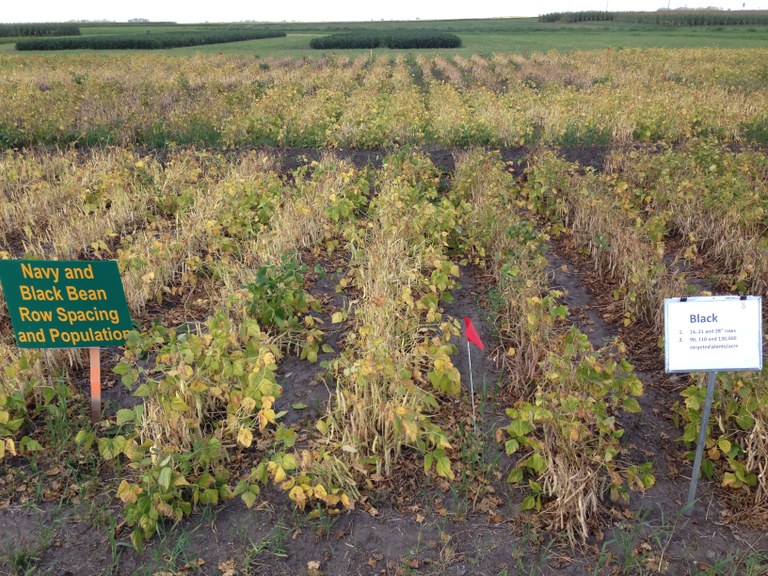Black Bean Seed Yield with Row Spacing and Plant Population
A field study, partially funded by Northarvest Bean Growers Association, is being conducted to examine the response of black bean to row spacing and plant population. ‘Eclipse’ was planted in 14-, 21- and 28-inch rows at 100,000, 125,000 and 150,000 pure live seeds (PLS)/acre at Carrington in 2014 and 2016-17. In addition, ‘Eclipse’ was planted at the three rates at Park River in 2014, and Prosper in 2014 and 2016-17.
Averaged across three years and plant populations at Carrington, 21-inch rows increased black bean seed yield by 240 lb/acre compared to 28-inch rows (Table 1). Yield with 14-inch rows was statistically similar to 21-inch rows.
| Table 1. Black bean seed yield with row spacing1, Carrington, 2014 and 2016-17. | ||||
| Row spacing | Seed yield (lb/acre) | |||
| Inches | 2007 | 2016 | 2017 | 3-year average |
| 14 | 1945 | 2356 | 2078 | 2126ab |
| 21 | 1860 | 3162 | 1988 | 2337a |
| 28 | 1595 | 2618 | 2074 | 2096b |
| LSD (0.10) | 210 | |||
| 1Variety='Eclipse'. Averaged across three plant populations. | ||||
Averaged across seven site-years and rows spacings, black bean planted at the low, medium and high rates produced 99,950, 118,530 and 140,480 plants/acre, respectively. Seed yield increased with the high- versus low-plant population, while the intermediate plant population was statistically similar to the high plant population (Table 2). Based on these data, return-on-investment would indicate that the intermediate planting rate would be appropriate.
| Table 2. Black bean response to plant population, North Dakota, 2014, 2016-17 (7 site-years)1. | ||
| Planting rate | Plant population | Seed yield |
| PLS/acre (x1000) | number/acre | lb/acre |
| 100 | 99,950 | 2430b |
| 125 | 118,530 | 2470ab |
| 150 | 140,480 | 2510a |
| LSD (0.10) | x | 75 |
| 1Variety='Eclipse'. Trial locations: Carrington and Prosper (2014, 2016-17); Park River (2014). Averaged across three row spacings at Carrington. | ||
These preliminary data would suggest black bean planted in narrow rows and with a planting rate to achieve 115,000 to 125,000 plants/acre would optimize yield potential. The study will be continued in 2018 at Carrington to expand the database before plant establishment recommendations by NDSU are revised for black bean.

Greg Endres
Gregory.Endres@ndsu.edu
Area Extension Agronomist
Other contributors: Hans Kandel, and Mike Ostlie.


